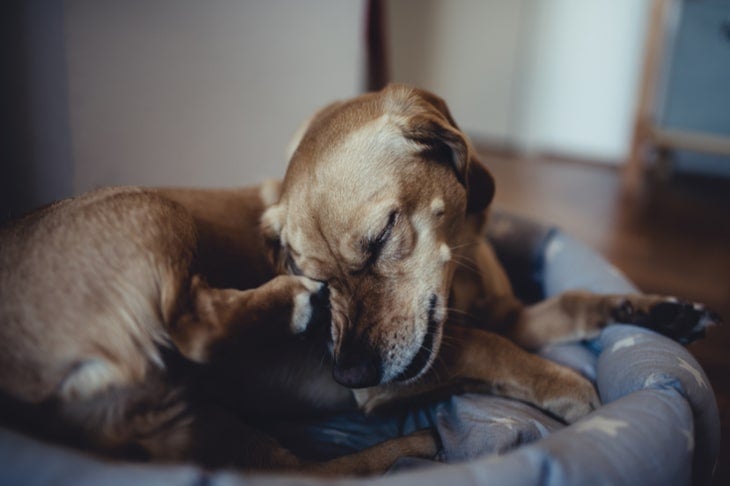Fleas are the bane of every dog parent. These little blood-suckers irritate your dog and can infest your house before you even realize it. Some dogs are allergic to flea saliva and develop intense, itchy rashes, flaky skin, hot spots, scabs, and hair loss. Fleas generally prefer animal hosts but have no qualms about biting people if an animal host is not available. In addition to the annoying, itchy bites they leave in their wake, fleas can also transmit diseases to your family and your dog.
But it doesn’t have to be that way. With proper flea & tick control for dogs, knowing the signs of flea infestation, an understanding of their life cycle, and a few preventive steps, you can keep your dog and your home flea-free.
Symptoms of Fleas
Of course, seeing a flea on your dog is a sure sign that a flea infestation may be brewing. If you see one flea, you can be sure that there are many more on your dog, and possibly in your home, that you don’t see.
A quick way to check your dog for fleas is to run a flea comb through their fur. If you see small darkish specks that move, you’ve found a flea. However, if you find some dark specs that don’t move, your pet may not be flea-free. These little specks may be flea dirt. Drop the flea comb into some water, and if it turns reddish-brown, your pet has fleas. You can also check for flea dirt in your home by wearing white socks and walking through areas where your dog relaxes or sleeps.
Below are other signs that may indicate a flea infestation is underway.
Excessive Scratching, Biting, or Licking
Once a flea lands on your dog, they make themselves at home in hard-to-reach places like the tail, groin, armpits, neck, and head. If you notice your dog scratching, biting, and licking at these areas, they probably have fleas.
Red, Irritated Patches of Skin
Some dogs are allergic to flea saliva. If this is the case for your dog, you may see welts at the bite site, and rashes can occur anywhere on their body.
Excessive Hair Loss
The constant itching at irritated areas can cause your dog to have excessive hair loss. However, there are other causes of hair loss in dogs, so speak with your veterinarian if you notice this symptom. The severity and pattern of the hair loss are vital in diagnosing its cause.
Pale Gums
If the infestation is severe, your dog may become anemic. The fleas may be consuming so much of your dog’s blood that their body’s red blood cell production can’t keep up. Pale gums are a common sign of anemia.
Lifecycle of Fleas
Understanding the flea lifecycle is the first step to getting a handle on flea control. Below is an outline of four stages of the flea lifecycle.
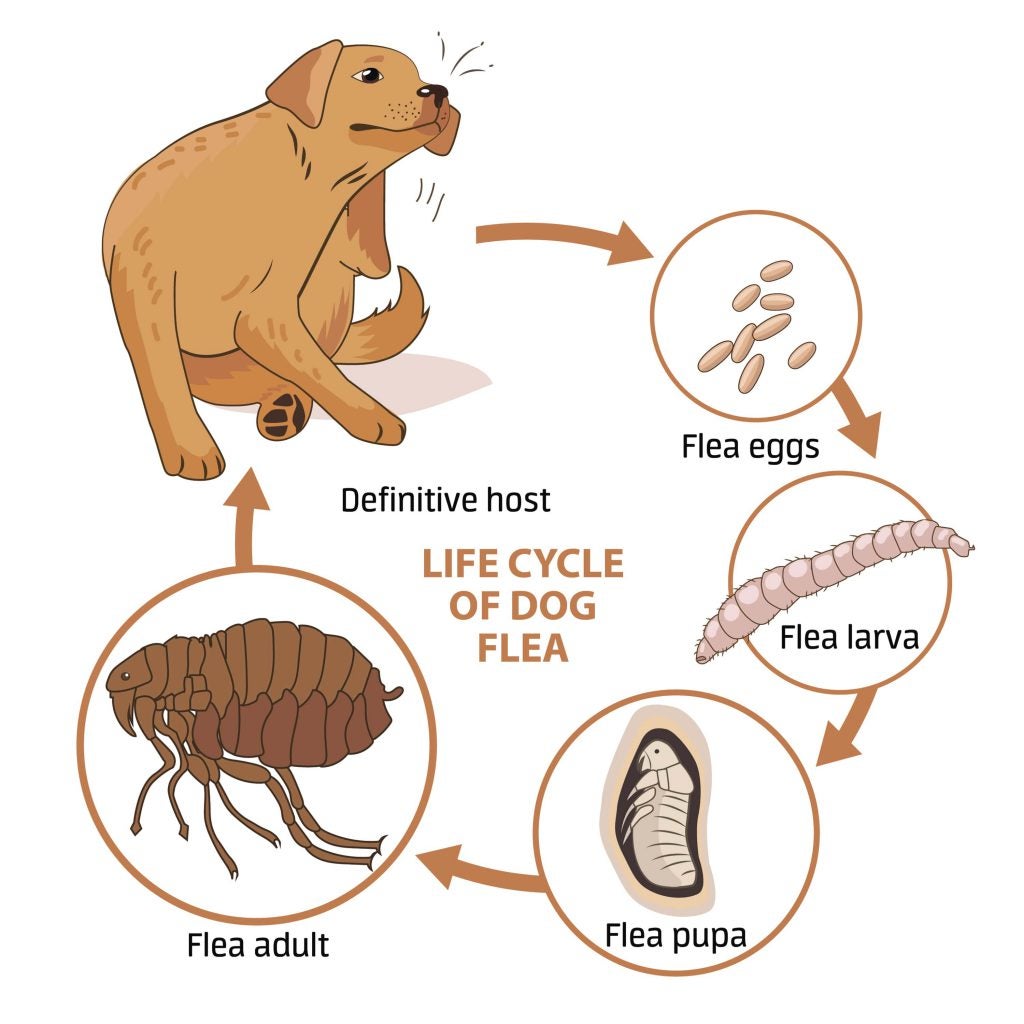
- Egg Stage – Female fleas lay their small, white, oval eggs on a host after consuming its blood. These tiny, hard-to-see eggs then drop off the host and into the environment. When the host is your dog, this means the eggs fall into their bed, the carpet, and the sofa.
- Larva Stage – After about 2-14 days, the eggs hatch into worm-like larvae. These larvae consume the flea dirt (pre-digested blood) of adult fleas. Flea larvae are about ¼ inches long, white, and legless. Within approximately 5-20 days, the larvae spin cocoons and enter the pupa stage.
- Pupa Stage – The cocoons’ sticky outer coating makes them hard to vacuum or sweep up from furniture and carpeting. It also protects the developing fleas from chemicals. This stage can last a week or several months, as the adult flea emerges only when a potential host is near.
- Adult Stage – When an appropriate host walks by, the adult flea emerges from the cocoon and begins to feed. Within a few days, the female flea breeds and begins to lay eggs. They cannot lay eggs until they’ve had a blood meal.
Understanding these life stages is key since different dog flea treatments target different parts of the flea life cycle. Carefully read the label of flea control products to see their active ingredients and how they eliminate fleas from your dog.
How to Treat Fleas on Your Dog
The best way to treat fleas on your dog is to apply topical flea medicine or administer flea tablets. These flea medicines are treatments and preventives and begin to work anywhere between 2 to 12 hours. They each have different active ingredients that work in different ways to treat and prevent flea infestations. Whichever product you choose, it is important to use it consistently and follow the directions on the label. This ensures you get the best results.
Topical Flea Treatments
K9 Advantix II
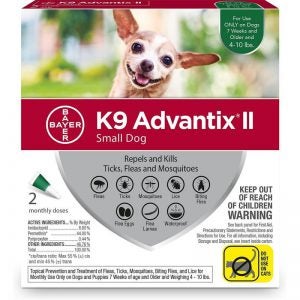
K9 Advantix II is a combination of three active ingredients, two neurotoxins, and one insect growth regulator (IGR). The neurotoxins affect the fleas’ nervous system and eventually kills them. The IGR slows the development of any flea eggs that hatch.
Frontline Plus
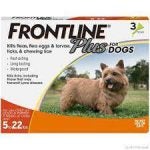
Recommended by vets for over 20 years, Frontline Plus contains two active ingredients — an IGR and a neurotoxin — to provide effective relief from the irritation of fleas, ticks, and lice. It effectively kills adult fleas and disrupts flea development life stages to stop reinfestations.
Bravecto Topical Solution for Dogs
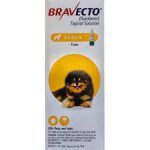
This topical kills adult fleas and prevents flea infestations. It offers 12 weeks of flea protection and is the longest-lasting topical available.
Oral Flea Treatments
Bravecto Chews

Available by prescription, Bravecto chews kill fleas and ticks for 12 weeks. The chews are formulated to be pleasant-tasting and can be given just like a delicious treat. It is the longest-lasting FDA-approved flea treatment.
Sentinel
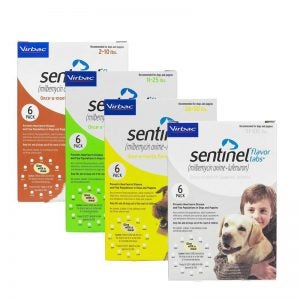
A prescription for Sentinel protects your dog from fleas, heartworm, and other parasites. It is given monthly, and while it kills adult fleas, it doesn’t keep flea eggs from hatching and maturing.
Simparica Trio for Dogs
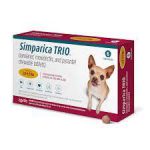
These chewables kill fleas and ticks and protect your dog from heartworm disease. They have a flavor that dogs enjoy, making giving flea prevention easy, and kill fleas before they have a chance to lay eggs.
Active Ingredients to Look for in Flea Control for Dogs
When looking at flea treatments for dogs, you’ll see a list of active ingredients and inactive ingredients. The active ingredients are the medical compounds that work to kill fleas and make your dog feel better. The inactive ingredients control the release of the medicine in your dog’s system, the consistency of a solution, or help a pill or chew keep its shape. They are basically there to ensure the mediation gets where it’s supposed to go.
Below are some of the most well-known active ingredients to look for in flea control products.
Lufenuron
Kills flea larvae
Lufenuron stops fleas from producing chitin, the substance that makes up the flea larvae’s outer shell. Without their outer shell, their inner organs are exposed to the air, and they die from dehydration shortly after hatching or molting.
Sarolaner
Kills adult fleas
Sarolaner causes uncontrolled neuromuscular activity in fleas, destroying their nervous system and causing their death.
Fluralaner
Kills adult fleas
Fluralaner can be administered topically or orally. It inhibits the flea’s nervous system and disrupts particular pathways, resulting in fatal seizures.
Fipronil
Kills adult fleas, tick, and lice
This is one of the most common and well-known pesticides used in many products and for different purposes. It destroys the flea’s nerve sensors and prevents their muscles from relaxing, overwhelming their nervous system and causing them to die. It does not kill flea eggs or larvae.
(S)-methoprene
Kills flea eggs and larvae
Methoprene is an IGR that stops fleas from developing into adults. It keeps the levels of juvenile growth hormone high, so flea never moves into the next growth stage.
Permethrin
Kills and repels fleas, ticks, lice, mosquitos, and biting flies
Permethrin is another neurotoxin that causes muscle spasms and paralysis in adult fleas. It kills insects that eat or touch it. This chemical is dangerous to cats.
Imidacloprid
Help kills fleas, flea larvae, and mosquitoes.
Imidacloprid mimics nicotine, which is toxic to insects. It damages their nervous system and prevents the nerves from sending the right signals to the body, so the insect eventually dies. Fleas don’t even have to bite your dog to be affected by this chemical. It also has larvicidal properties.
Pyriproxyfen
Kills flea eggs and larvae
Pyriproxyfen is a larvicidal and ovicidal chemical killing agent meaning it kills flea larvae and flea eggs due to its insect growth regulator (IGR) properties. Similar to the methoprene found in Frontline Plus, it affects the hormone pathways in insects.
Flea Infestation Eradication and Prevention Tips
- Eliminating fleas on your dog is just one part of the solution. You will also need to get rid of fleas in your home and lawn. These steps not only get rid of fleas they can also prevent future infestations.
- Wash your dog’s bedding and any soft toys in hot, soapy water. If they sleep in a crate, wash the bedding in the crate as well.
- Also, wash throw rugs, your bedding, bath mats, and blankets or cushions, or anywhere your dog likes to sleep.
- Run the vacuum over carpets, tiled floors, hardwoods, linoleum, upholstered furniture, and curtains. If your vacuum has a vacuum bag, dispose of it immediately in an outside trash bin. Do this regularly to catch all flea stages.
- Use a spot treatment to kill any fleas hiding in the carpet of upholstered furniture.
- Keep grass and other plants short to make your yard less appealing to fleas. Use a yard and premise spray if needed.
- Keep your dog on flea preventative.
If you have more than one pet, make sure to give them the appropriate flea prevention. It is always a good idea to discuss flea control with your veterinarian, as they are familiar with your dog and can advise you on the best and safest flea control for dogs.

